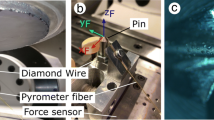Abstract
For over 20 years, wire sawing has been the primary method used for slicing ingots of silicon, sapphire, and silicon carbide into wafer substrates. Fixed diamond wire sawing has recently emerged as an alternative to slurry wire sawing as a means to shorten the time required for slicing and reduce the usage of slurry. The distribution of diamond grains on the wires strongly influences slicing performance in terms of material removal, surface topography, and subsurface damage. However, few studies have investigated this topic. This study established a model with which to simulate the distribution of diamond grains. Simulation results demonstrate that a higher density distribution reduces the rate of material removal because the loading is shared by the abrasives, thereby preventing the grains from penetrating deeply enough into the workpiece to facilitate the removal of material. Lower distribution density was shown to increase the loadings on the abrasives. These results demonstrate the importance of distribution density of diamond abrasives on the wire with regard to slicing performance.
Similar content being viewed by others
Abbreviations
- A hij :
-
Horizontal projected penetration area of the ith abrasive on the jth wire cross section
- A vij :
-
Vertical projected penetration area of the ith abrasive on the jth wire cross section
- AF ij :
-
The force applied on the ith abrasive on the jth wire cross section from wire tension
- c :
-
Length of lateral crack
- d :
-
Average wire cross-section interval
- E :
-
Yound’s modulus of material
- F j :
-
Tangential force applied to the jth wire cross section or jth abrasive in one-dimensional model
- H :
-
Hardness of material
- h :
-
Abrasive penetration depth
- h c :
-
Depth of the lateral crack
- h j :
-
Displacement of the jth wire cross section due to the normal loading N j
- K c :
-
Fracture toughness of material
- L :
-
Length of wire which is in contact with workpiece
- N j :
-
Normal loading applying to the jth wire cross section or jth abrasive in one-dimensional model
- n :
-
Number of wire cross sections
- P :
-
Pressure required to produce plastic deformation
- r ij :
-
Radius of the ith penetrated conical abrasive on the jth wire cross section
- T j :
-
Wire tension on the left hand side of the jth wire cross section or jth abrasive in one-dimensional model
- Q :
-
Material removal per sliding distance
- α ij :
-
Position angle of the ith diamond abrasive on the jth wire cross section
- β :
-
Bow angle of the wire
- β j :
-
Deviation angle of the jth wire segment with respect to the tangental direction of the jth wire cross section
- ϕ :
-
Half tip angle of diamond grain
References
Pei Z, Fisher GR, Liu J (2008) Grinding of silicon wafers: a review from historical perspectives. Int J Mach Tools Manuf 48:1297–1307
Kao I (2004) Technology and research of slurry wiresaw manufacturing systems in wafer slicing with free abrasive machining. Int J Adv Manuf Syst 7(2):7–20
Clark W, Shih A, Hardin C, Lemaster R, McSpadden S (2003) Fixed abrasive diamond wire machining- part i: process monitoring and wire tension force. Int J Mach Tools Manuf 43(5):523–532
Clark W, Shih A, Lemaster R, McSpadden S (2003) Fixed abrasive diamond wire machining- part ii: experiments design and results. Int J Mach Tools Manuf 43(5):533–542
Teomete E (2011) Investigation of long waviness induced by the wire saw process. Proceedings of the Institution of Mechanical Engineers. B J Eng Manuf 225(7):1153–1162
Pauli P, Beesley JG, Schonholzer UP, Kerat U (2005) Swiss wafer slicing technology for the global pv market from meyer + burger ag—novel trends for the future in photovoltaic wafer manufacturing. In: 6 Symposium Photovoltaic National SIG Geneve
Kray D, Schumann M, Eyer A, Willeke G, Kubler R, Beinert J, Kleer G (2007) Solar wafer slicing with loose and fixed grains. In: conference record of the 2006 IEEE 4th world conference on photovoltaic energy conversion, vol 1, pp 948–0951, Waikoloa
Chen CCA, Chao PH (2010) Surface texture analysis of fixed and free abrasive machining of silicon substrates for solar cells. Adv Mater Res 126–128:177–180
Chung C (2012) Abrasive distribution of the fixed diamond wire in wire sawing process. Adv Mater Res 579:145–152
Williams J (2005) Engineering Tribology. Cambridge University Press, New York
Chang Y, Hashimura M, Dornfeld D (2000) An investigation of material removal mechanisms in lapping with grain size transition. J Manuf Sci Eng 122(3):413–419
Moller HJ (2004) Basic mechanisms and models of multi-wire sawing. Adv Eng Mater 6(7):501–513
Patten J, Cherukuri H, Yan J (2004) Ductile regime machining of semiconductors and ceramics IoP(Institute of Physics). In: Gogotsi Y, Domnich Y (eds) High pressure surface science and engineering
Young HT, Liao H-T, Huang H-Y (2006) Surface integrity of silicon wafers in ultra precision machining. Int J Adv Manuf Technol 29:372–378
Lawn BR, Evans AG, Marshall DB (1980) Elastic/plastic indentation damage in ceramics: the median/radial crack system. J Amer Ceram Soc 63:574–581
Marshall DB, Lawn BR, Evans AG (1982) Elastic/plastic indentation damage in creamics: the lateral crack system. J Amer Ceram Soc 65(11):561–566
Lawn B (1993) Fracture of brittle solids, 2nd edn. Cambridge University Press, Cambridge
Bhagavat S, Kao I (2007) Ultra-low load multiple indentation response of materials: in purview of wiresaw slicing and other free abrasive machining (fam) processes. Int J Mach Tools Manuf 47(3–4):666–672
Author information
Authors and Affiliations
Corresponding author
Rights and permissions
About this article
Cite this article
Chung, C., Tsay, G.D. & Tsai, MH. Distribution of diamond grains in fixed abrasive wire sawing process. Int J Adv Manuf Technol 73, 1485–1494 (2014). https://doi.org/10.1007/s00170-014-5782-y
Received:
Accepted:
Published:
Issue Date:
DOI: https://doi.org/10.1007/s00170-014-5782-y




